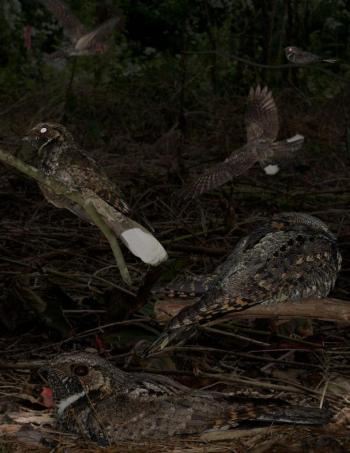Birds That Say Their Name
In the waning days of spring migration and our monitoring of the calls of night-migrating birds, our listening station picked up the loud, characteristic “kill-deer, kill-deer, kill-deer” call of the bird species of the same name, the killdeer. Killdeer are one of the earliest migrants in Maine, sometimes showing up after just a few of warmer southerly winds in late February, certainly by March. The one that flew over our house at midnight was probably more likely a local wanderer rather than a true migrant (but who knows for sure?).
While killdeer is a species well-named for the sound it makes, the name by itself doesn’t convey any information about the kind of bird it is, its life history characteristics, or what it looks like. Its closest relatives have names like semipalmated plover and black-bellied plover. Those names let you quickly know that the two species are related to each other and that one has a black belly, and the other, feet that are partially webbed. In fact, the semipalmated plover looks like a small version of the killdeer, with one black stripe across its chest instead of the two that the killdeer displays. It’s easy to imagine an early ornithologist naming the bird the “two-banded plover” or the “double-banded plover.” Interestingly, both of those names are now officially in use for two different plovers that have two bands across the breast—one from southern South America and the other from New Zealand.
The killdeer is in heady company when it comes to its name, as there are relatively few of our birds named for the sounds they make. One of the most familiar among this illustrious group are our beloved chickadees—here in Maine, the familiar black-capped chickadee as well as the less common boreal chickadee, which is confined to northern and eastern Maine. Audubon himself mentioned the name in his writing, although he officially called them by the name “titmouse” as in the “black-capped titmouse.”
Two common flycatchers found here in Maine are named after their distinctive calls—the phoebe, or more specifically, the eastern phoebe, whose regular song sounds like “fwee-bwee,” and the pewee, officially the “eastern wood-pewee,” which is often confused by sight with the phoebe but whose vocalizations include a long whistled “peee-a-wee.”
One of our favorite birds named after is the whip-poor-will. This rather mysterious member of the nightjar family calls and feeds only at night, so very few people ever see one. Decades ago, though, the sound of the whip-poor-will at night was common across much of the state. We remember the stories Grandmother Chase told of the whip-poor-wills that would keep the family awake on summer nights in Edgecomb during the 1940s. There are many Whip-poor-will Lanes and Whip-poor-will Drives and Whip-poor-will Roads across the state. Anyone who has driven the road between Wiscasset and Gardiner will probably be familiar with the sign for Whippoorwill Hill Road where, presumably, the distinctively whistled “whip-poor-will, whip-poor-will, whip-poor-will” echoed on many a summer evening in years past. Sadly, the sound of the whip-poor-will is not known to many people today unless they are older or are birders who have searched them out in the few places where they can now be found in the state. Whip-poor-wills are among a suite of insect-eating birds that have experienced major declines over the last 40 years. The reasons for the decline are poorly understood as the birds are difficult to study because of their nocturnal habits. Declines are probably the result of a combination of factors that include habitat loss/degradation and drops in insect prey populations as a result of pesticides and pollution.
There are a handful of other birds named after their calls, among them the towhee, willet, and bobolink. We are not entirely sure but suspect that the veery, with its “veer” call, may be another.
There are likely others, too, and many more that just barely missed the mark. If the species had been named for sound of its call rather than the animal the call sounds like, we might be calling the catbird the “meow bird”—imagine that!
Jeffrey V. Wells, Ph.D., is a Fellow of the Cornell Lab of Ornithology and Vice President of Boreal Conservation for the National Audubon Society. Dr. Wells is one of the nation's leading bird experts and conservation biologists and author of “Birder’s Conservation Handbook”. His grandfather, the late John Chase, was a columnist for the Boothbay Register for many years. Allison Childs Wells, formerly of the Cornell Lab of Ornithology, is a senior director at the Natural Resources Council of Maine, a nonprofit membership organization working statewide to protect the nature of Maine. Both are widely published natural history writers and are the authors of the book, “Maine’s Favorite Birds” and “Birds of Aruba, Bonaire, and Curaçao: A Site and Field Guide” from Cornell Press.























